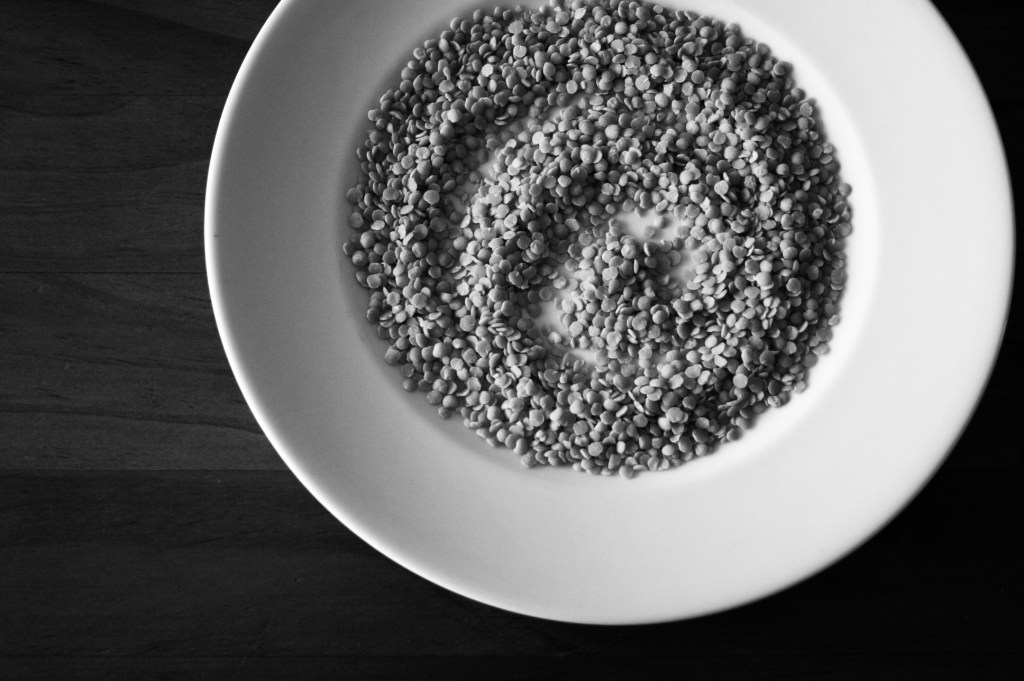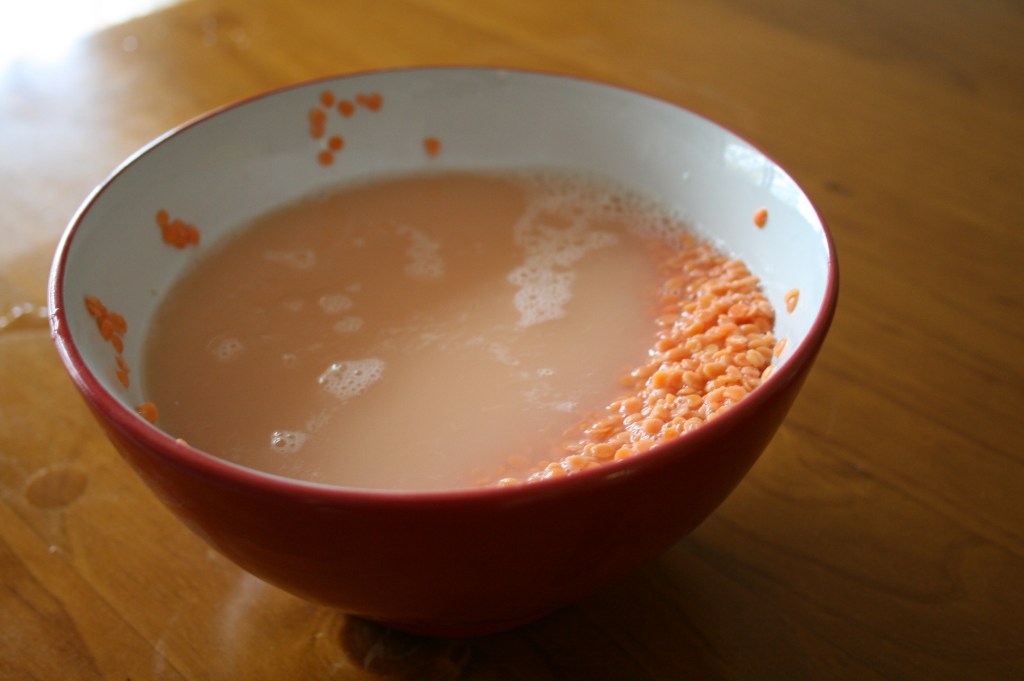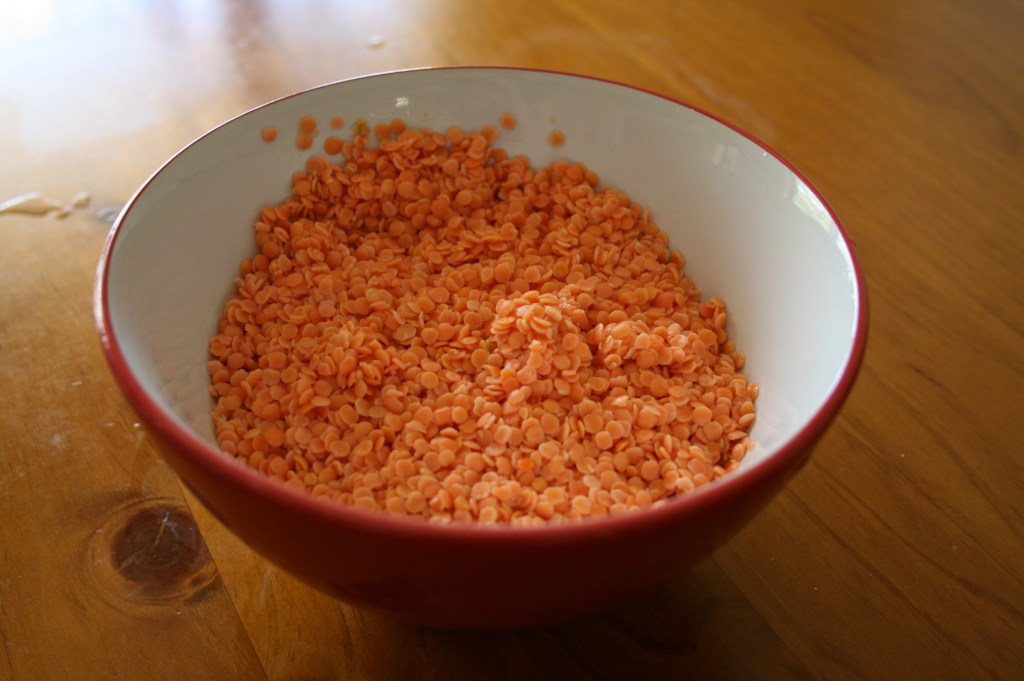
So much for carnivorousness, I can’t get enough of lentils lately. I’ve written about lentils before, so you know about their late appearance in my diet. What I haven’t written about is their first, and how I learned to cook them.
When I was 16 a couple stayed in the cottage my grandparents used to rent out on their farm. The pair had recently returned to New Zealand after several years living and working as missionaries in India. They continued to cook the vegetarian Indian cuisine they had grown to love, and one day the woman (her name escapes me) offered to teach me how to make dhal and chapati. Not only was it my first taste of lentils, but also the first time that I cooked with spices like ground cumin and coriander, both now staples in my kitchen. I recall that we used garam masala as well, which still sounds wonderfully exotic to my ears.

The tiny size of lentils means that it is easy for small stones, clumps of dirt and other foreign objects like wheat, to go unnoticed during the packaging process. Therefore, the first step in cooking lentils is to thoroughly sort and wash them. My teacher on that day thoroughly drummed into my head the importance of washing lentils, telling me that in India, bits of glass and animal dung frequently lurked in addition to stones, dirt and wheat. Her method for sorting lentils involved tipping them in thin layers onto a large flat plate, meticulously sorting them a little at a time. The lentils I buy these days tend to be reasonably free of extranea, so I have fallen into the lazy practice of slowly sprinkling the lentils into a large bowl and relying on my eyes to notice anything unusual. I still religiously follow her washing procedure however.
To wash lentils properly, I was taught to place them in a large bowl and fill it with plenty of cold water. Scoop up handfuls of the lentils and scrub them by rubbing your palms together. Split red lentils are usually quite dusty, and the water will turn milky very quickly. After a thorough scrubbing, drain off the water and refill with clean water. Swish the water, drain, and repeat until the water runs clear. This usually takes six or seven rinses for red lentils, split peas and moong dhal, and as little as two for green or brown lentils.



I remember that day that the pungent onions made my eyes water terribly, and that I rubbed them in search of relief, stupidly not realising that I still had fresh onion juice on my hands. Later, the dhal we had prepared didn’t exactly win me over. I think that the intense spices and mealy texture were just too strange for a 16-year-old reared on a conventional New Zealand diet. Fast forward a few years…(ok, ok, maybe 15-ish, cough, cough), and I love lentils – I love how easy they are to prepare, how nourishing they are, how light and easy to digest, how they take on flavours so readily.
So, now that you have a bowl of freshly washed lentils, one of the easiest things to do with them is to make soup. I have a whole raft of lentil soup recipes in regular rotation throughout winter; this one is only the most recent acquisition. I found it originally in a food blog I’ve been reading lately, but the recipe actually originates from the back of the MacKenzie’s red lentil packet. I’ve constructed my own version of the soup drawing from elements of both. It’s humble and comforting, and best of all, comes together with minimal effort in no more than 45 minutes.
Red Lentil and Sweet Potato Soup
1 tablespoon extra-virgin coconut oil, or olive oil
1 large onion, finely chopped
1 large garlic clove, finely chopped
1 Tbsp fresh ginger, finely grated
1 teaspoon ground cumin
1/2 teaspoon ground turmeric
1 cup red lentils, sorted and washed
1 medium sweet potato, peeled and cut into chunks (or kumara, for NZers)
2 medium carrots, peeled and diced
5-6 cups water
Tamari or sea salt to taste
Freshly ground black pepper
Chopped flat leaf parsley
Heat the coconut oil in a large heavy-based pan over a medium heat. Add onion and sweat for a few minutes. Add the garlic, ginger and spices, and gently fry for another few minutes.
Add the lentils, sweet potato, carrots and water and bring to the boil. Lower the heat and simmer for 30 minutes or until the lentils are falling apart and the carrot and sweet potatoes are tender.
Season the mixture with tamari or salt and freshly ground black pepper, then puree using a stick blender. I usually start with about 1 Tbsp tamari or 1 tsp salt, and then add more as required. Serve topped with plenty of chopped parsley.

Pingback: Rummaniyeh | Aubergine, Lentil, Pomegranate | Chez Moi
I’ve never thought to puree lentils in soup. I usually keep them whole but can’t wait to give this a try!
The red ones start to break down when fully cooked so they are halfway to the blender already. I like them left as they are as well, but the soup turns such a lovely bright orange when puréed that I normally take the extra step.
thank you!
also, maybe you have an idea how to wash quinoa? The grains are so small and I broke my tooth with a stone the same size in the ready food. I wash always in in the sieve with the smallest holes but half of the grains goes through them with water 😉 but pieces of glass of the same size remain – so nasty and scary when they get into the food!
If there are glass fragments and stones in the quinoa (scary alright) then it will be important to sort through the dry grains before you wash them. I would recommend spreading the grains on a flat plate and sorting through carefully, a little at a time. As for washing the grains, well I use a fine sieve too and don’t have any trouble with escaping grains. Maybe you need a finer sieve? Or perhaps line your sieve with a piece of muslin to keep he grains together. Good luck!
thank you!
This was very clear and helpful! Thanks so much!! I’m trying to cook yummy food on a budget and am excited to start loving lentils like you 🙂
Best of luck with your lentil experiments! Thanks for the feedback 🙂
Interesting information about washing lentils and the recipe looks great!
Thank you 🙂
Hi! I love moong dal which is like lentils. Question, I soak them first for a few hours. Do you recommend this?
Hi Kelly, I never soak red lentils or moong dal as they take so little time to cook. It’s personal preference really – if soaking them first gets dinner ready in half the time then that would be a bonus for many people. Thanks for stopping by.
Hello! Thanks for stopping by my site. Cheers Lidija
You’re welcome Lidija. You take beautiful photographs so I will definitely be back!
I love dahl and lentil soups! I also tend to soak my lentils, but often not red ones as they don’t take long to break down. I think i’ll have a look around while i’m here 🙂
Red lentils are the legumes for busy people! I also use a lot of green and black lentils for salads as in that situation you want them to retain a little bite. Thanks for visiting 🙂
Great looking recipe – I must try it.
Let me know how it goes! Thanks for commenting 🙂
Pingback: 2012: In review | Chez Moi
Pingback: Spring food & Smashed Broccoli Penne | Chez Moi